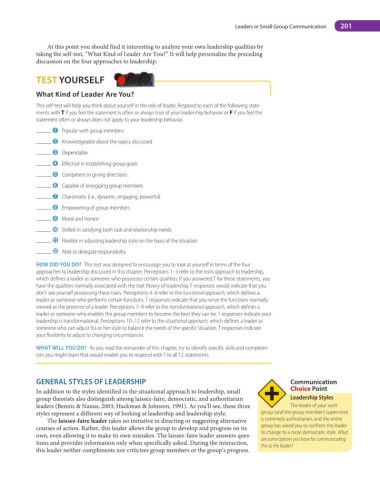Page 222 - Essentials of Human Communication
P. 222
Leaders in Small Group Communication 201
At this point you should find it interesting to analyze your own leadership qualities by
taking the self-test, “What Kind of Leader Are You?” It will help personalize the preceding
discussion on the four approaches to leadership.
test YourseLf
What Kind of Leader are You?
This self-test will help you think about yourself in the role of leader. Respond to each of the following state-
ments with T if you feel the statement is often or always true of your leadership behavior or F if you feel the
statement often or always does not apply to your leadership behavior.
_____ ➊ Popular with group members
_____ ➋ Knowledgeable about the topics discussed
_____ ➌ Dependable
_____ ➍ Effective in establishing group goals
_____ ➎ Competent in giving directions
_____ ➏ Capable of energizing group members
_____ ➐ Charismatic (i.e., dynamic, engaging, powerful)
_____ ➑ Empowering of group members
_____ ➒ Moral and honest
_____ ➓ Skilled in satisfying both task and relationship needs
_____ 11 Flexible in adjusting leadership style on the basis of the situation
_____ 12 Able to delegate responsibility
HOw dId YOu dO? This test was designed to encourage you to look at yourself in terms of the four
approaches to leadership discussed in this chapter. Perceptions 1–3 refer to the traits approach to leadership,
which defines a leader as someone who possesses certain qualities. If you answered T for these statements, you
have the qualities normally associated with the trait theory of leadership. F responses would indicate that you
don’t see yourself possessing these traits. Perceptions 4–6 refer to the functional approach, which defines a
leader as someone who performs certain functions. T responses indicate that you serve the functions normally
viewed as the province of a leader. Perceptions 7–9 refer to the transformational approach, which defines a
leader as someone who enables the group members to become the best they can be. T responses indicate your
leadership is transformational. Perceptions 10–12 refer to the situational approach, which defines a leader as
someone who can adjust his or her style to balance the needs of the specific situation. T responses indicate
your flexibility to adjust to changing circumstances.
wHat wIll YOu dO? As you read the remainder of this chapter, try to identify specific skills and competen-
cies you might learn that would enable you to respond with T to all 12 statements.
General stYles OF leadersHIP Communication
In addition to the styles identified in the situational approach to leadership, small Choice point
group theorists also distinguish among laissez-faire, democratic, and authoritarian leadership styles
leaders (Bennis & Nanus, 2003; Hackman & Johnson, 1991). As you’ll see, these three The leader of your work
styles represent a different way of looking at leadership and leadership style. group (and the group members’ supervisor)
The laissez-faire leader takes no initiative in directing or suggesting alternative is extremely authoritarian, and the entire
courses of action. Rather, this leader allows the group to develop and progress on its group has asked you to confront the leader
own, even allowing it to make its own mistakes. The laissez-faire leader answers ques- to change to a more democratic style. What
tions and provides information only when specifically asked. During the interaction, are some options you have for communicating
this to the leader?
this leader neither compliments nor criticizes group members or the group’s progress.

